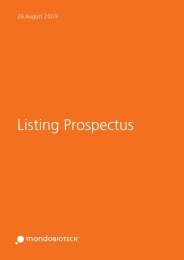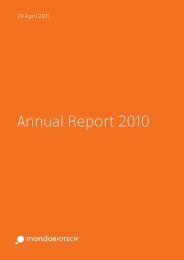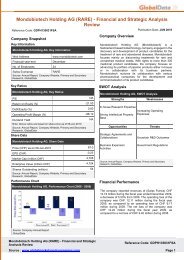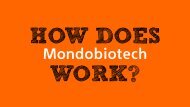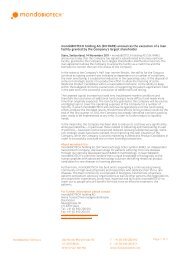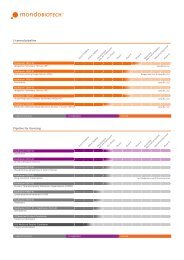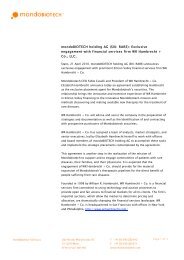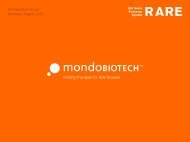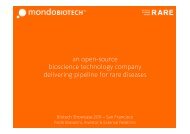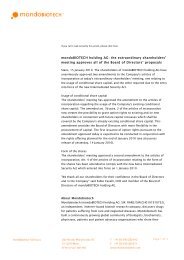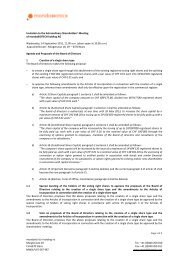Mondobiotech Holding AG Company presentation
Mondobiotech Holding AG Company presentation
Mondobiotech Holding AG Company presentation
You also want an ePaper? Increase the reach of your titles
YUMPU automatically turns print PDFs into web optimized ePapers that Google loves.
<strong>Mondobiotech</strong> <strong>Holding</strong> <strong>AG</strong><br />
<strong>Company</strong> <strong>presentation</strong><br />
April 2012
Disclaimer<br />
The shares of mondoBIOTECH holding <strong>AG</strong> are traded since August 26 th , 2009<br />
on the SIX Swiss Exchange with the symbol RARE<br />
This document expressly or implicitly contains<br />
certain forward-looking statements concerning<br />
mondoBIOTECH holding <strong>AG</strong> and its business.<br />
Such statements involve certain known and<br />
unknown risks, uncertainties and other factors,<br />
which could cause the actual results, financial<br />
condition, performance or achievements of<br />
mondoBIOTECH holding <strong>AG</strong> to be materially<br />
different from any future results, performance<br />
or achievements expressed or implied by such<br />
forward-looking statements. mondoBIOTECH<br />
holding <strong>AG</strong> is providing this communication as<br />
of this date and does not undertake to update<br />
any forward-looking statements contained<br />
herein as a result of new information, future<br />
events or otherwise.<br />
This document does not constitute or form<br />
part, or all, of any offer or invitation to sell<br />
or issue, neither in the United States of<br />
America nor elsewhere, or any solicitation of<br />
any offer to purchase or subscribe for, any<br />
securities, nor shall part, or all, of this<br />
document or its distribution form the basis<br />
of, or be relied on in connection with, any<br />
contract or investment decision in relation to<br />
any securities. This document cannot be<br />
distributed without prior formal written<br />
consent from mondoBIOTECH holding <strong>AG</strong>.<br />
2
mondoBIOTECH at a glance<br />
• Headquartered in Stans, Switzerland, mondoBIOTECH holding <strong>AG</strong> is a public biotech company (SIX Swiss Exchange ticker symbol: RARE) that discovers drugs<br />
– peptides of human origin – for rare and neglected diseases<br />
• The <strong>Company</strong> identifies effective and safe medicinal product candidates (“MPC”) through redirecting existing and known substances into new<br />
therapeutic indications by utilizing an innovative proprietary methodology called Search&Match. This process searches and analyses peptides and other<br />
biological immuno-modulating substances that are naturally occurring in the human body in order to detect promising candidates for the development<br />
of medicinal products<br />
• Once the Medicinal Product Candidate is recognized the <strong>Company</strong> partners with the relevant communities or parties and then validates its discovery<br />
through its Community of leading experts in the Orphan Diseases Market (“the Rare Community”)<br />
• The Search&Match engine combined with the knowledge and resources of our worldwide orphan scientific community has so far identified more then 80<br />
MPC’s<br />
• mondoBIOTECH licenses or sells its MPC’s to third parties (such as pharmaceutical or biotechnology companies) and/or collaborate with third parties to<br />
obtain market authorization to commercialize such candidates<br />
10 Orphan drug<br />
designations<br />
in EU and US<br />
8 MPCs Ready for Licensing<br />
19 Patents<br />
granted<br />
81<br />
Medicinal<br />
product<br />
candidates<br />
22 Patent<br />
Families<br />
filed<br />
312 Peptides<br />
to redirect in<br />
rare diseases<br />
3
Management<br />
Ruggero<br />
Gramatica<br />
CEO<br />
Dorian<br />
Bevec<br />
CSO<br />
Paolo<br />
Barbieri<br />
CFO<br />
Maria Teresa<br />
D’Antonangelo<br />
Bühlmann<br />
Corporate Affairs<br />
Business Support<br />
Ruggero has extensive experience in startups having successfully delivered growth and expansion<br />
to 6 companies in the technology arena worldwide. He brings strategic leadership and operational<br />
expertise. He has masterminded the bio-mathematical model which supports the company’s research<br />
approach and he remains academically involved in research activity in the field of Applied Mathematics<br />
with Kings College, London. Ruggero attended ‘Politecnico di Milano’ and obtained a BS-Eng and<br />
an MSc in Electrical Engineering and holds an MBA from the University of Chicago.<br />
Dr. Habil. Dorian Bevec is <strong>Mondobiotech</strong>’s Chief Scientific Officer and a co-founder of <strong>Mondobiotech</strong>.<br />
Dorian Bevec holds a Ph.D. (Dr. rer. nat.) from the Ludwig-Maximilians University of Munich and a<br />
habilitation (Venia Docendi) from the University of Vienna. Prior to that, Dorian had worked as Head of<br />
Molecular Biology and project team leader at the Sandoz Research Institute in Vienna for ten years and<br />
previously at Axxima <strong>AG</strong> in Martinsried.<br />
Paolo brings over 25 years of senior management, financial and capital market experience. Prior to joining<br />
mondoBIOTECH, he was Deputy CEO and Chief Investment Officer at Pioneer Alternative Investments, he<br />
has successfully founded and managed Akros HFR Alternative Investments and has been Managing<br />
Director and Head of Equity Capital Markets at Banca Akros.<br />
Maria Teresa is an attorney-at-law and is admitted to bar since 2003. She gained an in-depth knowledge<br />
and experience in international commercial law and intellectual property law, with a specialization in<br />
patents and copyright. Before joining <strong>Mondobiotech</strong> in 2005, she worked as associate in the law-firm<br />
Freshfield Bruckhaus Deringer in Milan and Paris and from 2001 until 2005 as senior associate in the law<br />
firm Avvocati Associati in Milan.<br />
4
Board of Directors<br />
Robert Edward<br />
Patterson<br />
Chairman<br />
MD, Peninsula Venture<br />
Graf Francis<br />
von Seilern-Aspang<br />
CEO Industrie<br />
u. Finanzkontor<br />
Prinz Michael von<br />
und zu Liechtenstein<br />
Vice-Chairman<br />
Marc<br />
Häsler<br />
Etude Häsler,<br />
H&B Law<br />
Ruggero<br />
Gramatica<br />
CEO mondoBIOTECH<br />
Vincenzo<br />
Romano<br />
MC Consulting Suisse<br />
Prof. Dr.<br />
Michael A. Keller<br />
Stanford University<br />
5
Search&Match<br />
A bio-mathematical model
Our approach to drug discovery<br />
• In today’s world, scientific and medical information is extremely fragmented and dispersed throughout<br />
millions of publications. Our technology makes it accessible and retrievable at low cost<br />
• In fact, our internally-developed bio-mathematical methodology platform enables us to structure a<br />
vast amount of validated and qualified information onto knowledge-based cloud, allowing our<br />
scientists to connect information on rare diseases with a knowledge of biologically-active peptides<br />
• The platform provides the rationale for new or “redirected” uses of peptides against rare diseases<br />
• As many companies are cutting or externalizing R&D costs, <strong>Mondobiotech</strong> is delivering a steady stream<br />
of medicinal products for early clinical development<br />
7
Introduction to the Search&Match methodology<br />
Dry search rather than classical laboratory research<br />
We developed a Search&Match process focusing on analysis of immunomodulating<br />
substances naturally occurring in the human body, in order to<br />
identify promising candidates for the development of medicinal products<br />
specifically targeted to the treatment of rare diseases<br />
8
Introduction to the Search&Match methodology<br />
Search<br />
31000 journals and 50million publications<br />
Search algorithms that:<br />
• Access privileged qualified data sources for<br />
collecting all knowledge on human peptides<br />
and rare diseases<br />
• Elaborate all relevant information<br />
• Populate our database to feed the<br />
bio-mathematical model for the Match<br />
Search<br />
Physical<br />
Records<br />
Libraries of Periodicals<br />
& Textbooks<br />
Electronic<br />
Records<br />
Publications in<br />
Multiple Languages<br />
Academia<br />
Diagrams<br />
& Images<br />
Lab Results<br />
Peptide<br />
Match<br />
312 peptides with 7000 rare diseases<br />
Match algorithms that:<br />
• Apply our bio-mathematical model to link the<br />
gathered information on peptides,<br />
physiological pathways and resulting biological<br />
activities with the patho-physiological signs &<br />
symptoms of rare diseases<br />
• Create multiple peptide-disease matches<br />
generating the best possible medicinal<br />
platforms candidates<br />
Match<br />
Disease<br />
Therapies<br />
MPC<br />
9
The human disease network<br />
Goh K-I, Cusick ME, Valle D, Childs B, Vidal M, Barabasi ! A-L (2007) Proc Natl Acad Sci USA 104:8685-8690<br />
Coats<br />
Osteopetrosis<br />
disease<br />
Caffey<br />
Exudative<br />
disease<br />
vitreoretinopathy Norrie<br />
439<br />
disease<br />
Nevo<br />
Hyperostosis,<br />
syndrome<br />
endosteal<br />
217<br />
Oligodontia<br />
Osteogenesis Osteoporosis<br />
Ehlers-Danlos imperfecta<br />
syndrome<br />
Arthropathy<br />
Hypodontia<br />
Myasthenic<br />
733 syndrome<br />
Heart<br />
3-methylglutaconicaciduria<br />
Optic<br />
Marfan<br />
block<br />
atrophy<br />
Aortic syndrome<br />
aneurysm<br />
Intervertebral_disc<br />
Brugada<br />
disease<br />
Glaucoma<br />
syndrome<br />
Cramps,<br />
Cleft<br />
potassium-aggravated Myotonia<br />
palate<br />
congenita<br />
Oculodentodigital<br />
MASS<br />
Hypokalemic<br />
Acquired<br />
dysplasia<br />
long_QT_syndrome<br />
Epiphyseal<br />
Keratitis<br />
Eye<br />
syndrome<br />
periodic<br />
Ectopia<br />
paralysis<br />
dysplasia<br />
Atelosteogenesis<br />
Capillary<br />
Basal_cell<br />
anomalies<br />
Marshall<br />
Larson<br />
Holoprosencephaly<br />
Coloboma,<br />
malformations<br />
Incontinentia<br />
syndrome<br />
syndrome<br />
carcinoma<br />
ocular<br />
pigmenti<br />
26<br />
Aniridia,<br />
Long_QT<br />
Osteoarthritis<br />
Diastrophic<br />
type_II<br />
syndrome<br />
dysplasia<br />
Medulloblastoma<br />
Branchiootic<br />
Morning<br />
Atrioventricular<br />
syndrome<br />
glory<br />
Foveal<br />
Ectodermal<br />
Achondrogenesis_Ib<br />
disc<br />
hypoplasia<br />
block<br />
dysplasia<br />
anomaly<br />
942<br />
126<br />
CPT<br />
Kniest<br />
830<br />
Bart-Pumphrey<br />
Cataract<br />
deficiency,<br />
syndrome Erythrokeratoderma<br />
dysplasia<br />
Iridogoniodysgenesis<br />
hepatic<br />
Iris_hypoplasia<br />
843<br />
OSMED<br />
Enhanced Bothnia<br />
and_glaucoma Axenfeld<br />
Alagille<br />
syndrome<br />
S-cone retinal 1105<br />
1104<br />
anomaly<br />
syndrome<br />
syndromedystrophy<br />
Butterfly<br />
Maculopathy,<br />
845<br />
Atrial<br />
Fechtner<br />
549 dystrophy,<br />
bull’s-eye<br />
retinal<br />
fibrillation<br />
792<br />
May-Hegglin syndrome<br />
anomaly Epstein<br />
Fundus<br />
Epidermolytic<br />
EBD<br />
syndrome<br />
albipunctatus<br />
Miyoshi<br />
hyperkeratosis 396<br />
myopathy<br />
Myopathy<br />
434<br />
Becker<br />
Night<br />
muscular<br />
Duchenne<br />
Deafness<br />
Ichthyosiform<br />
Myotilinopathy<br />
blindness<br />
dystrophy<br />
muscular<br />
erythroderma Ichthyosis<br />
847<br />
Creatine<br />
dystrophy<br />
Epidermolysis<br />
phosphokinase<br />
144<br />
bullosa<br />
Muscular<br />
868<br />
dystrophy<br />
Mohr-Tranebjaerg<br />
Cone<br />
Cardiomyopathy<br />
syndromeJensen<br />
dystrophy<br />
McCune-Albright<br />
syndrome<br />
Dentin<br />
Meniere<br />
syndrome<br />
dysplasia,<br />
GRACILE<br />
Alexander<br />
disease<br />
type_II<br />
syndrome<br />
Convulsions<br />
Menkes<br />
disease<br />
418<br />
disease<br />
Osseous<br />
Enlarged<br />
Leber<br />
heteroplasia<br />
1016<br />
vestibular<br />
congenital_amaurosis<br />
Barth<br />
aqueduct<br />
Occipital_horn<br />
Leigh<br />
syndrome<br />
syndrome<br />
Acromegaly<br />
474<br />
Macular<br />
Cutis<br />
Dejerine-Sottas<br />
syndrome<br />
1113<br />
Hemolytic-uremic<br />
laxa<br />
disease<br />
syndrome<br />
degeneration<br />
Maple_syrup_urine<br />
Achromatopsia<br />
Neuropathy<br />
Factor_x<br />
Hypertriglyceridemia<br />
disease<br />
deficiency<br />
913<br />
Charcot-Marie-Tooth<br />
Leprechaunism<br />
Nephropathy-hypertension<br />
disease<br />
Apolipoprotein<br />
Hypoalphalipoproteinemia<br />
Amyotrophic<br />
594<br />
deficiency<br />
lateral<br />
Lipodystrophy<br />
Hypoglycemia<br />
Hypercholesterolemia<br />
sclerosis<br />
Insulin<br />
117<br />
resistance<br />
Hyperproinsulinemia<br />
Myocardial<br />
Corneal<br />
803<br />
Hyperinsulinism<br />
infarction<br />
dystrophy<br />
275<br />
Amyloidosis<br />
558<br />
Hypobetalipoproteinemia<br />
Diabetes<br />
Coumarin<br />
Amyloid<br />
Lissencephaly<br />
Nicotine<br />
Myeloperoxidase<br />
resistance<br />
mellitus<br />
Dysfibrinogenemia<br />
neuropathy<br />
addiction<br />
Non-Hodgkin<br />
deficiency<br />
Keratoconus<br />
Abetalipoproteinemia<br />
Infantile_spasm<br />
lymphoma<br />
463<br />
Epilepsy<br />
377<br />
syndrome<br />
Hyperproreninemia<br />
Glioblastoma<br />
Afibrinogenemia<br />
MODY<br />
Myoclonic<br />
Myelodysplastic<br />
Hyperlipoproteinemia<br />
epilepsy<br />
syndrome<br />
Hypofibrinogenemia<br />
Coffin-Lowry<br />
Myelogenous<br />
Alzheimer<br />
syndrome<br />
1057<br />
Androgen<br />
leukemia<br />
Autoimmune<br />
Mental<br />
insensitivity<br />
Macrocytic<br />
137<br />
disease<br />
disease<br />
Fanconi-Bickel<br />
Ataxia<br />
anemia<br />
syndrome<br />
Hemorrhagic<br />
retardation<br />
930<br />
diathesis<br />
Gastric<br />
1153<br />
Emphysema<br />
Asperger<br />
Adenoma,<br />
syndrome<br />
Apert 379<br />
cancer<br />
Muir-Torre<br />
periampullary<br />
syndrome 192 Listeria<br />
syndrome<br />
Hypercholanemia<br />
Homocystinuria<br />
monocytogenes<br />
Nonsmall_cell<br />
Desmoid Ataxia-telangiectasia<br />
Obesity<br />
lung_cancer<br />
Cafe-au-lait<br />
198<br />
Autism<br />
disease<br />
spots<br />
Hypertension<br />
Adenomas<br />
Gardner<br />
Allergic<br />
Hyperprolinemia<br />
syndrome<br />
Angelman<br />
809<br />
Jackson-Weiss<br />
rhinitis<br />
syndrome<br />
syndrome<br />
Neuroectodermal<br />
Crouzon<br />
tumors<br />
Leanness,<br />
Atherosclerosis<br />
Aarskog-Scott<br />
Craniosynostosis syndrome<br />
Hepatic<br />
inherited<br />
Liddle<br />
Neutropenia<br />
syndrome<br />
Adenocarcinoma<br />
syndrome<br />
adenoma<br />
Alcohol<br />
Kallmann<br />
dependence<br />
syndrome<br />
Endometrial Breast<br />
Lymphoma<br />
Graft-versus-host<br />
Anorexia<br />
Neurofibrosarcoma<br />
carcinoma<br />
disease<br />
cancer<br />
Asthma<br />
nervosa<br />
Dementia<br />
96<br />
Colon<br />
1096<br />
HIV<br />
182<br />
Hematopoiesis,<br />
Obsessive-compulsive<br />
129<br />
cyclic<br />
422<br />
Lhermitte-Duclos Fanconi<br />
cancer<br />
Neurofibromatosis Neurofibromatosis<br />
Estrogen<br />
IgE_levels<br />
disorder<br />
syndrome anemia<br />
resistance<br />
Li-Fraumeni<br />
QTL<br />
1140<br />
syndrome<br />
Leprosy<br />
Cerebral<br />
Oligodendroglioma<br />
Giant-cell<br />
Migraine<br />
amyloid<br />
fibroblastoma<br />
Meningioma<br />
Muenke<br />
HDL_cholesterol<br />
Cancer<br />
angiopathy<br />
syndrome<br />
level_QTL<br />
susceptibility<br />
Coronary<br />
Hypochondroplasia<br />
Lung<br />
Hirschsprung<br />
artery<br />
Achondroplasia<br />
Denys-Drash<br />
Cervical<br />
cancer<br />
Melanoma<br />
disease<br />
Memory<br />
disease<br />
Mesothelioma<br />
syndrome<br />
Cowden carcinoma<br />
impairment<br />
Mesangial<br />
disease<br />
Nijmegen_breakage<br />
Atopy<br />
Histiocytoma<br />
Malaria<br />
sclerosis<br />
Birt-Hogg-Dube<br />
syndrome<br />
287<br />
Frasier<br />
syndrome Leukemia<br />
Bare_lymphocyte<br />
syndrome<br />
Benzene<br />
syndrome<br />
ABCD<br />
Germ_cell<br />
toxicity<br />
syndrome<br />
378<br />
833<br />
Nasopharyngeal<br />
carcinoma<br />
tumor<br />
Netherton<br />
Neuroblastoma<br />
Bladder<br />
syndrome<br />
cancer<br />
Aquaporin-1<br />
Esophageal<br />
441<br />
deficiency<br />
cancer<br />
Growth<br />
hormone<br />
347<br />
Adult_i<br />
Blood<br />
Orolaryngeal<br />
Leopard Noonan Lipoma<br />
Multiple<br />
phenotype<br />
Carney<br />
cancer<br />
syndrome syndrome<br />
endocrine<br />
Li<br />
group<br />
complex<br />
Loeys-Dietz<br />
neoplasia<br />
Myxoma,<br />
syndrome Fraumeni<br />
Dyserythropoietic<br />
intracardiac<br />
syndrome<br />
anemia<br />
Albinism<br />
Costello<br />
syndrome<br />
Macrothrombocytopenia<br />
Adrenocortical<br />
Anemia<br />
carcinoma Hyperthroidism<br />
959 Mast_cell<br />
leukemia<br />
Hemangioblastoma,<br />
Huntington<br />
Elliptocytosis<br />
Hypothyroidism<br />
cerebellar<br />
disease<br />
Gastrointestinal<br />
Insensitivity<br />
stromal<br />
to_pain<br />
Hemolytic<br />
tumor<br />
Angiofibroma,<br />
anemia<br />
sporadic<br />
Hyperparathyroidism<br />
Goiter<br />
Creutzfeldt-Jakob<br />
Graves<br />
disease Insomnia<br />
Myelofibrosis,<br />
Omenn<br />
disease<br />
idiopathic<br />
Episodic<br />
syndrome<br />
G6PD<br />
ataxia<br />
Gerstmann-Straussler<br />
Favism deficiency<br />
Hemiplegic_migraine, disease<br />
Hyperthyroidism<br />
familial<br />
604<br />
Hypereosinophilic<br />
Hypocalciuric<br />
1056<br />
syndrome<br />
Cerebellar<br />
hypercalcemia<br />
Adenosine_deaminase<br />
Merkel_cell<br />
ataxia<br />
deficiency<br />
Carcinoidcarcinoma<br />
Hypocalcemia<br />
tumors,<br />
intestinal<br />
1164<br />
Urolithiasise<br />
van_Buchem<br />
NDP<br />
disease<br />
SLC34A1<br />
LRP5<br />
COL1A1<br />
PLOD1<br />
PAX9<br />
Aneurysm,<br />
COL3A1<br />
COL1A2<br />
familial_arterial<br />
Witkop<br />
syndrome<br />
OPA3<br />
Pseudoachondroplasia<br />
WISP3<br />
MSX1<br />
OPA1<br />
Paramyotonia<br />
Sick_sinus<br />
congenita<br />
syndrome 3558<br />
SCN4A<br />
Syndactyly<br />
Spondyloepiphyseal COMP<br />
Weill-Marchesani Shprintzen-Goldberg<br />
COL9A2<br />
dysplasia<br />
syndrome<br />
syndrome<br />
SCN5A<br />
Zlotogora-Ogur<br />
2785<br />
syndrome<br />
Parkes_Weber<br />
Basal_cell<br />
FBN1<br />
COL9A3<br />
1432<br />
syndrome<br />
1414<br />
CYP1B1<br />
nevus_syndrome<br />
Peters<br />
FLNB<br />
RASA1<br />
PTCH<br />
anomaly<br />
Thyrotoxic<br />
MATN3<br />
SHH<br />
periodic<br />
KCNH2<br />
PVRL1<br />
paralysis<br />
GJA1<br />
SLC26A2<br />
PTCH2<br />
Wagner<br />
PAX6<br />
IKBKG<br />
syndrome<br />
CACNA1S<br />
Optic_nerve<br />
COL11A1<br />
EYA1<br />
hypoplasia/aplasia<br />
KCNE1<br />
Rieger<br />
LOR<br />
SMED<br />
COL2A1 Strudwick_type<br />
syndrome<br />
PITX2 FOXC1<br />
Ring_dermoid<br />
PITX3<br />
of_cornea<br />
KCNE2<br />
1586 Stickler<br />
syndrome<br />
Vohwinkel<br />
NKX2-5<br />
syndrome<br />
GJB6<br />
RYR1<br />
KCNQ1<br />
Tetralogy<br />
GJB3<br />
CRYAB<br />
CPT2<br />
of_Fallot<br />
GJB2<br />
COL11A2<br />
Central_core<br />
Self-healing<br />
disease<br />
Retinal_cone<br />
collodion_baby<br />
J<strong>AG</strong>1<br />
NR2E3 RLBP1<br />
dsytrophy<br />
KRT10<br />
1518<br />
Macular VMD2<br />
Toenail<br />
Sebastian<br />
dystrophy<br />
dystrophy,<br />
MYH7<br />
MYH9<br />
NRL<br />
RDS<br />
Vitelliform<br />
TGM1<br />
isolated<br />
DYSF<br />
MYH6<br />
syndrome<br />
MYF6<br />
macular<br />
1401<br />
ELOVL4<br />
Stargardt<br />
dystrophy<br />
COL7A1<br />
ABCA4<br />
DES<br />
MYO7A<br />
RHO<br />
Rippling_muscle<br />
disease<br />
KRT1<br />
DSP<br />
disease<br />
DMD<br />
PCDH15<br />
Retinitis<br />
1229<br />
STS<br />
MYOT<br />
PDE6B<br />
EYA4<br />
TIMM8A<br />
CRB1<br />
5233<br />
PLEC1<br />
CDH23<br />
Usher<br />
USH2A<br />
pigmentosa<br />
LAMA3<br />
1545<br />
CAV3<br />
COCH<br />
USH1C<br />
syndrome<br />
CRX<br />
Somatotrophinoma<br />
RYR2<br />
Walker-Warburg FCMD<br />
DSPP<br />
Ventricular<br />
syndrome<br />
TTN<br />
AIPL1<br />
tachycardia<br />
SLC26A4<br />
MASS1<br />
POMT1<br />
GUCY2D<br />
SGCD<br />
PRK<strong>AG</strong>2<br />
RPE65<br />
GNAI2<br />
1232<br />
Wolff-Parkinson-White<br />
GNAS<br />
BCS1L<br />
TCAP<br />
syndrome<br />
Pendred<br />
RPGR<br />
syndrome<br />
RPGRIP1<br />
TAZ<br />
NDUFV1<br />
RP1<br />
Roussy-Levy<br />
COX15<br />
ATP7A<br />
syndrome<br />
SDHA<br />
NDUFS4<br />
FBLN5<br />
Williams-Beuren<br />
Pseudohypoparathyroidism<br />
PMP22<br />
1297<br />
LMNA<br />
PDHA1<br />
CFH<br />
CNGB3<br />
ELN<br />
syndrome<br />
EGR2<br />
Vertical<br />
GCSL<br />
talus<br />
Stroke<br />
Supravalvar_aortic<br />
MPZ<br />
Rabson-Mendenhall<br />
stenosis<br />
HOXD10<br />
syndrome<br />
HSPB1<br />
Pelizaeus-Merzbacher<br />
1396<br />
3212<br />
disease<br />
ALOX5AP F7<br />
PLP1 Spastic_ataxia<br />
DCTN1<br />
/paraplegia<br />
1347<br />
INSR<br />
APOA2<br />
ALS2<br />
GARS<br />
BSCL2<br />
KCNJ11<br />
Primary<br />
HEXB<br />
lateral_sclerosis<br />
APOA1<br />
VAPB<br />
ABCC8<br />
Spinal_muscular<br />
TCF2<br />
atrophy<br />
SARS,<br />
progression_of<br />
APOB<br />
PAFAH1B1<br />
COL8A2<br />
FOXP3<br />
1456<br />
INS<br />
THBD<br />
TTR<br />
VSX1<br />
Squamous_cell<br />
APOE<br />
carcinoma<br />
Sea-blue_histiocyte<br />
FGA<br />
CYP2A6<br />
PPARG<br />
CHRNA4<br />
ACE<br />
DCX<br />
LGI1<br />
GCK<br />
disease<br />
MPO<br />
2385<br />
GABRG2<br />
ACSL6<br />
HNF4A<br />
Renal<br />
FGB<br />
KCNQ2<br />
FAS<br />
IPF1<br />
tubular<br />
APP<br />
CACNB4<br />
REN<br />
SLC6A8<br />
SLC2A2<br />
ARX<br />
dysgenesis<br />
FGG<br />
CASP10<br />
Pancreatic<br />
Thrombophilia<br />
ENPP1<br />
RPS6KA3<br />
agenesis<br />
Perineal<br />
RETN<br />
<strong>AG</strong>TR1 <strong>AG</strong>T<br />
F5<br />
Partington<br />
IRF1<br />
CBS<br />
hypospadias<br />
syndrome<br />
AR<br />
ERBB2 CASP8<br />
HSD11B2<br />
Preeclampsia EPHX1<br />
SERPINA1<br />
NLGN4X<br />
Proud<br />
PTPN22<br />
syndrome<br />
TCF1<br />
Coronary<br />
Thrombocytopenia<br />
Saethre-Chotzen<br />
NOS3<br />
spasms<br />
NLGN3<br />
MECP2<br />
syndrome<br />
Schizophrenia<br />
SOX3<br />
Pfeiffer<br />
1183<br />
Placental<br />
KLF6<br />
ATM<br />
Wiskott-Aldrich<br />
FGD1<br />
Ovarian<br />
MSH2<br />
abruption<br />
PRODH<br />
syndrome<br />
FGFR2<br />
ADRB2<br />
syndrome<br />
CDH1<br />
cancer<br />
MLH1<br />
NR3C2<br />
WAS<br />
Pilomatricoma<br />
Systemic_lupus<br />
PSEN1<br />
PPM-X<br />
BRCA1<br />
APC<br />
Turcot<br />
CTNNB1<br />
erythematosus<br />
SCNN1B<br />
Pseudohypoaldosteronism<br />
syndrome Rett<br />
MUTYH<br />
MAD1L1<br />
syndrome<br />
EGFR<br />
<strong>AG</strong>RP<br />
Pick<br />
syndrome<br />
FGFR1<br />
Rheumatoid<br />
IL13<br />
disease<br />
Seasonal<br />
PIK3CA<br />
Prostate<br />
PMS2<br />
arthritis<br />
affective_disorder<br />
SCNN1G<br />
FCGR3A<br />
RAD54L<br />
RAD54B<br />
HTR2A<br />
MSX2<br />
cancer<br />
T-cell<br />
IL10<br />
ALOX5<br />
MXI1<br />
lymphoblastic<br />
ECE1<br />
ELA2<br />
Parietal<br />
leukemia<br />
Viral<br />
foramina<br />
Supranuclear<br />
infection<br />
1555<br />
BAX<br />
BRAF<br />
palsy<br />
MAPT<br />
PTEN<br />
BRIP1<br />
PDGFRL<br />
PHF11<br />
AXIN2<br />
1174<br />
NF1<br />
PLA2G7<br />
ATP1A2<br />
SLC6A4<br />
BRCA2<br />
1476<br />
MSH6<br />
TNF<br />
EP300<br />
Watson<br />
PDGFB<br />
FGFR3<br />
CHEK2<br />
Rubenstein-Taybi MET syndrome<br />
PARK2<br />
ESR1<br />
Simpson-Golabi-Behmel<br />
Osteosarcoma<br />
Multiple<br />
Platelet<br />
syndrome<br />
SNCA<br />
syndrome<br />
1490<br />
malignancy<br />
RUNX1<br />
defect/deficiency<br />
GPC3<br />
XRCC3<br />
TP53 syndrome BCL10 Sezary<br />
Sepsis<br />
BDNF<br />
ABCA1<br />
SLC22A18<br />
FLCN<br />
syndrome<br />
GDNF<br />
Wilms<br />
CD36<br />
tumor<br />
KRAS<br />
CCND1<br />
Tangier<br />
NF2<br />
Parkinson<br />
EDNRB<br />
disease<br />
CIITA<br />
WT1<br />
NBN<br />
Schwannomatosis Pancreatic<br />
disease<br />
Waardenburg-Shah<br />
Stomach Adrenal_cortical<br />
W<strong>AG</strong>R<br />
1239<br />
EDN3<br />
syndrome<br />
Rhabdomyosarcoma<br />
cancer cancer carcinoma<br />
PCWH<br />
Tietz<br />
syndrome<br />
TGFBR2<br />
SPINK5<br />
PHOX2B<br />
SOX10<br />
Thyroid<br />
NQO1<br />
syndrome<br />
Shah-Waardenburg<br />
BMPR1A carcinoma<br />
STK11<br />
DBH<br />
syndrome<br />
PAX3<br />
Renal_cell<br />
TAP2<br />
1614<br />
RET<br />
SMAD4<br />
Peutz-Jeghers<br />
STAT5B<br />
MITF<br />
syndrome<br />
carcinoma<br />
LPP<br />
Waardenburg<br />
Multiple<br />
Wegener<br />
von_Hippel-Lindau<br />
syndrome<br />
PTPN11<br />
sclerosis<br />
granulomatosis<br />
GYPC<br />
syndrome<br />
Polyposis<br />
GATA1<br />
AQP1<br />
HRAS<br />
3229<br />
PRKAR1A<br />
RB1<br />
CDKN2A<br />
KIT<br />
Medullary_thyroid<br />
TYR<br />
TBP<br />
carcinoma<br />
Pyropoikilocytosis<br />
PTPRC<br />
GCNT2<br />
TSHR<br />
Retinoblastoma<br />
VHL<br />
SPTA1<br />
Spherocytosis<br />
MYH8<br />
NTRK1<br />
Piebaldism<br />
HMGA2<br />
SLC4A1<br />
Polycythemia<br />
Carcinoid_tumor<br />
Salivary<br />
of_lung<br />
RHCE<br />
1528<br />
adenoma<br />
MEN1<br />
SPTB<br />
Spinocereballar<br />
Adrenal<br />
Uterine<br />
ataxia<br />
Parathyroid<br />
adenoma<br />
leiomyoma<br />
adenoma<br />
1267<br />
Renal<br />
JAK2 Pheochromocytoma<br />
1383<br />
tubular<br />
RH<strong>AG</strong><br />
DCLRE1C<br />
TG<br />
CDC73<br />
1263<br />
Rh-negative<br />
acidosis<br />
CTLA4<br />
PRNP<br />
R<strong>AG</strong>1<br />
blood_type<br />
CACNA1A<br />
G6PD<br />
Rh-mod<br />
Thyroid<br />
GSS<br />
syndrome<br />
hormone TPO<br />
PDGFRA<br />
R<strong>AG</strong>2<br />
SDHB<br />
resistance<br />
SDHD<br />
PGK1<br />
Autoimmune<br />
IL2RG<br />
thyroid<br />
CASR<br />
3512 disease<br />
Thrombocythemia<br />
ADA<br />
Paragangliomas<br />
Combined<br />
immunodeficiency<br />
CP<br />
C6<br />
665<br />
Hypoceruloplasminemia<br />
Complement_component<br />
deficiency<br />
Frontometaphyseal<br />
Amelogenesis<br />
dysplasia<br />
CRASH<br />
Nonaka<br />
H._pylori<br />
584<br />
1119<br />
461<br />
Diabetes<br />
Smith-Fineman-Myers<br />
Ceroid-lipofuscinosis Microcephaly Hyperekplexia<br />
syndrome<br />
Chorea,<br />
infection<br />
Crohn<br />
Adrenomyeloneuropathy<br />
imperfecta<br />
1265<br />
myopathy<br />
Restrictive insipidus<br />
Tropical<br />
Adrenocortical<br />
Rapp-Hodgkin<br />
syndrome<br />
disease Melnick-Needles<br />
Hypoaldosteronism<br />
OPN1MW<br />
BCG<br />
calcific<br />
Ovarioleukodystrophy<br />
MASA<br />
Agammaglobulinemia<br />
Bosley-Salih-Alorainy<br />
hereditary<br />
Pseudohermaphroditism,<br />
syndrome<br />
Situs<br />
GP1BB<br />
FUT2<br />
dermopathy,<br />
insufficiency<br />
infection<br />
Synpolydactyly<br />
Juberg-Marsidi<br />
Leiomyomatosis<br />
pancreatitis<br />
ambiguus DLX3<br />
syndrome<br />
syndrome<br />
benign<br />
ADULT<br />
Colorblindness<br />
DiGeorge syndrome<br />
Hypohaptoglobinemia<br />
Guttmacher<br />
535<br />
male<br />
Sialuria<br />
syndrome<br />
Acrocapitofemoral<br />
syndrome<br />
Blue-cone<br />
Bernard-Soulier<br />
Bombay<br />
GLRA1<br />
lethal<br />
Leydig<br />
Sutherland-Haan<br />
ENAM<br />
CARD15<br />
EIF2B2<br />
syndrome<br />
Crigler-Najjar3037<br />
syndrome<br />
Blau<br />
syndrome<br />
syndrome<br />
phenotype<br />
Greenberg<br />
cell<br />
Limb-mammary<br />
Orofacial cleft<br />
PPT1<br />
RAPADILINO<br />
ABCD1<br />
1335<br />
Micropenis<br />
syndrome-like DNAH11 Trichodontoosseous<br />
FLNA EIF2B5<br />
dysplasia<br />
monochromacy<br />
Iron<br />
HOXA1<br />
HSPG2<br />
Ceroid<br />
dysplasia<br />
syndrome<br />
HPFH<br />
adenoma<br />
syndrome<br />
syndrome<br />
POLG<br />
GNE<br />
MCPH1<br />
BTK<br />
TITF1<br />
Startle<br />
AVPR2<br />
IFNGR1<br />
NR5A1<br />
HOXD13<br />
SPINK1<br />
785 syndrome<br />
EIF2B4<br />
294<br />
lipofuscinosis<br />
Hay-Wells<br />
Heterotopia<br />
CYP11B2<br />
van_der_Woude<br />
Alpers<br />
Hyperbilirubinemia<br />
overload/deficiency<br />
Basal<br />
disease<br />
ATRX<br />
320<br />
syndrome<br />
Kartagener<br />
Psoraisis<br />
Velocardiofacial L1CAM<br />
LHCGR<br />
FH<br />
syndrome<br />
ganglia 3260<br />
HOXA13<br />
Precocious<br />
Bethlem<br />
Otopalatodigital<br />
syndrome<br />
Analbuminemia<br />
162<br />
syndrome<br />
891<br />
syndrome<br />
Inclusion IRF6<br />
HP<br />
1611<br />
Neurodegeneration disease<br />
Mycobacterial<br />
ROR2<br />
IHH<br />
TP73L<br />
OPN1LW<br />
Weyers<br />
ZMPSTE24<br />
puberty,<br />
18<br />
Chudley-Lowry<br />
myopathy<br />
syndrome<br />
Low renin<br />
1361<br />
1080<br />
77<br />
body<br />
infection<br />
Adrenoleukodystrophy<br />
Brachydactyly<br />
Pancreatitis<br />
male<br />
Sarcoidosis<br />
EEC syndrome<br />
syndrome<br />
hypertension<br />
1376<br />
UGT1A1<br />
Sickle<br />
acrodental<br />
LBR<br />
RECQL4<br />
92<br />
Fumarase<br />
myopathy<br />
SERPINA3<br />
Sex<br />
Hand-foot-uterus<br />
reversal<br />
Tuberculosis<br />
cell<br />
COL6A1<br />
TBX1<br />
TF<br />
Popliteal<br />
FTL dysostosis<br />
deficiency<br />
Anhaptoglobinemia<br />
syndrome<br />
anemia<br />
PANK2<br />
945<br />
Hypertrypsinemia<br />
Split-hand/foot<br />
DNAH5<br />
Hemangioma<br />
pterygium Fish-eye<br />
SOX9 Pelger-Huet<br />
Hypogonadotropic<br />
Ewing<br />
Palmoplantar<br />
Abacavir 171<br />
734<br />
Hydrocephalus<br />
Atransferrinemia<br />
sarcoma<br />
hypersensitivity<br />
357<br />
Gilbert<br />
Opremazole<br />
disease<br />
anomaly<br />
Rothmund-Thomson<br />
HBB<br />
malformation<br />
DNAI1<br />
COL6A3<br />
ALB<br />
syndrome<br />
Tall<br />
syndrome<br />
87<br />
HARP<br />
727<br />
syndrome<br />
1133<br />
CFTR<br />
hypogonadism<br />
COL6A2<br />
keratoderma<br />
poor metabolizer<br />
stature<br />
EVC<br />
STAT1<br />
279<br />
Campomelic Hypophosphatemic<br />
Methemoglobinemia<br />
Cystic<br />
syndrome<br />
Kenny-Caffey<br />
1227<br />
1565<br />
1446<br />
Ciliary<br />
Cleidocranial dysplasia<br />
Alpha-actinin-3<br />
fibrosis<br />
Hemophilia<br />
679<br />
Plasminogen<br />
rickets<br />
2327<br />
IFNG<br />
GDF5<br />
syndrome-1<br />
3144<br />
Chondrodysplasia, 1466<br />
1542<br />
FLT4<br />
PEX10<br />
KRT16<br />
Erythremias Acromesomelic<br />
dyskinesia<br />
Kininogen<br />
453<br />
deficiency<br />
Grebe<br />
EWSR1<br />
DRD5<br />
Periodontitis<br />
CYP2C19 LCAT<br />
Craniometaphyseal dysplasia<br />
deficiency WHIM<br />
BCOR<br />
STAT1<br />
SLC45A2<br />
HLA-B<br />
PEX5<br />
dysplasia<br />
deficiency<br />
Proguanil<br />
dysplasia Ellis-<br />
syndrome<br />
deficiency<br />
PEX13<br />
type<br />
2354<br />
GNRHR<br />
VKORC1 F9<br />
AIDS<br />
Acrocallosal<br />
Lymphedema<br />
Blepharospasm<br />
CINCA<br />
Hypermethioninemia<br />
van Creveld<br />
Aplastic<br />
Fertile<br />
Ocular<br />
Pachyonychia<br />
poor metabolizerNorum<br />
Wolman PLG<br />
MCM6<br />
Smith-McCort<br />
FGF23<br />
MBL2 TBCE<br />
PAX2<br />
syndrome Chondrosarcoma<br />
Ankylosing<br />
syndrome<br />
Hypophosphatasia<br />
anemia<br />
539<br />
spoldylitis<br />
Conjunctivitis,<br />
syndrome<br />
Heinz<br />
eunuch<br />
albinism<br />
congenita<br />
Mephenytoin disease<br />
dysplasia<br />
PEX1<br />
PEX26<br />
KRIT1<br />
KNG1<br />
disease<br />
ACTN3<br />
Trichothiodystrophy<br />
body<br />
Dosage-sensitive<br />
syndrome<br />
ligneous<br />
Hypolactasia,<br />
Microphthalmia<br />
1580<br />
Tay-Sachs<br />
CTSC<br />
RUNX2<br />
Paget<br />
Zellweger<br />
HBA1<br />
sex<br />
Hex_A<br />
Dystonia<br />
poor metabolizer<br />
MAT1A<br />
ANKH<br />
Renal<br />
disease<br />
FOXC2<br />
adult<br />
disease Calcinosis,<br />
CXCR4<br />
GLI3<br />
Meningococcal 780<br />
anemia<br />
Red hair/<br />
Fitzgerald factor<br />
Buschke-Ollendorff<br />
Wolfram<br />
hypoplasia,<br />
syndrome<br />
reversal<br />
ERCC3<br />
MC1R<br />
ALPL<br />
tumoral<br />
107<br />
pseudodeficiency<br />
Pallister-Hall<br />
deficiency Haim-Munk<br />
type<br />
DYM<br />
Dental<br />
471<br />
disease<br />
fair skin<br />
KRT17 Ovarian<br />
syndrome syndrome<br />
1001<br />
Alopecia<br />
Aldosteronism<br />
Debrisoquine<br />
Chondrocalcinosis<br />
anomalies,<br />
Hyalinosis,<br />
Hyperandrogenism<br />
Down<br />
1002<br />
syndrome<br />
4291<br />
CIAS1<br />
syndrome<br />
isolated<br />
TERC<br />
LIPA<br />
Tuberous<br />
ERCC2<br />
CYP2C9<br />
626<br />
sensitivity<br />
isolated<br />
universalis<br />
infantile<br />
syndrome<br />
Hyperprothrombinemia Osteopoikilosis<br />
699 Coproporphyria Mevalonicaciduria<br />
Myelokathexis,<br />
sclerosis<br />
UV-induced<br />
EXT1<br />
Yellow<br />
dysgenesis<br />
Tolbutamide<br />
nail<br />
Polydactyly<br />
Steatocystoma<br />
5170<br />
TNFRSF11A<br />
Exostoses<br />
344<br />
HPRT-related<br />
701<br />
isolated<br />
systemic<br />
Thalassemias<br />
Xeroderma<br />
skin damage<br />
poor<br />
syndrome<br />
NR0B1<br />
HEXA<br />
multiplex<br />
Papillon-Lefevre<br />
Septooptic<br />
452<br />
Dyskeratosis<br />
PXMP3<br />
metabolizer Lowe<br />
FSHR<br />
Lead<br />
Beckwith-Wiedemann<br />
Hypoprothrombinemia syndrome<br />
Sialidosis gout<br />
313Odontohypophosphatasia<br />
Resting<br />
McKusick-Kaufman<br />
pigmentosum<br />
LEMD3<br />
WFS1<br />
HR<br />
dysplasia<br />
HBA2<br />
Cartilage-hair syndrome<br />
syndrome<br />
Spondylometaphyseal<br />
Leri-Weill<br />
poisoning<br />
Ovarian syndrome<br />
Muckle-Wells<br />
CYP2D6<br />
heart<br />
CYP21A2<br />
MTR<br />
MTRR<br />
dysplasia hypoplasia<br />
GM-gangliosidosis dyschondrosteosis Langer<br />
syndrome<br />
982<br />
rate<br />
Osteolysis<br />
Nemaline<br />
Virilization<br />
sex cord<br />
CPOX<br />
F2<br />
HPRT1<br />
MVK<br />
SLC3A1<br />
ANTXR2<br />
TSC2 TSC1<br />
CYP11B1<br />
ERCC5<br />
OCRL<br />
mesomelic<br />
ALAD<br />
Nephronophthisis<br />
Twinning, tumors<br />
Anderson<br />
Atrichia w/<br />
Longevity<br />
myopathy<br />
Metachromatic<br />
Codeine<br />
disease<br />
646<br />
Hypochromic<br />
210<br />
Refsum<br />
COL10A1<br />
dysplasia<br />
1526<br />
dizygotic<br />
papular lesions<br />
microcytic<br />
53<br />
292<br />
329<br />
1519<br />
SLC17A5<br />
HESX1<br />
DKC1<br />
RMRP<br />
leukodystrophy<br />
Lesch-Nyhan<br />
sensitivity<br />
ADRB1<br />
disease<br />
Spina<br />
SHOX<br />
Hyperalphalipoproteinemia<br />
syndrome,<br />
Harderoporphyrinuria<br />
Hyper-IgD Hematuria,<br />
MKKS<br />
Fibromatosisl<br />
anemia<br />
Dent<br />
GLB1<br />
Cystinuria<br />
Erythrocytosis<br />
disease<br />
Double-outlet<br />
Dysprothrombinemia<br />
1238 Salla<br />
CYP19A1<br />
bifida<br />
syndrome familial_benign<br />
Lymphangioleiomyomatosis<br />
Metaphyseal<br />
Porphyria<br />
NSD1<br />
1438<br />
disease<br />
Darier 1050<br />
chondrodysplasia<br />
Short<br />
Weaver<br />
Combined<br />
ERCC6<br />
HADHA<br />
NPHP4<br />
Synostoses<br />
right ventricle<br />
HyperphenylalaninemiaThymine-uraciluria<br />
Cholelithiasis<br />
Congestive<br />
Aromatase disease<br />
LIG4<br />
syndrome<br />
Hoyeraal-Hreidarsson 545<br />
Hemoglobi_H<br />
Mucopolysaccharidosis<br />
stature<br />
syndrome<br />
hyperlipemia<br />
FOXL2<br />
PEX7<br />
NPHP1<br />
syndrome<br />
CETP<br />
PSAP<br />
SFTPC<br />
TPM2<br />
Schindler<br />
heart<br />
Premature<br />
deficiency<br />
disease<br />
Homocysteine<br />
syndrome<br />
MTHFD1<br />
PTHR1<br />
LCHAD<br />
CFC1<br />
SAR1B<br />
failure 969 ovarian<br />
De Sanctis-Cacchione<br />
deficiency 527<br />
Pulmonary disease<br />
COL4A4<br />
Pituitary<br />
CLCN5<br />
HFE<br />
plasma<br />
Bardet-Biedl<br />
Nephrolithiasis<br />
Sotos<br />
LPL<br />
Combined<br />
PDGFRB<br />
POR<br />
NOG<br />
PAH<br />
failure<br />
hormone<br />
1325<br />
Antley-Bixler<br />
Senior-Loken<br />
syndrome Cockayne<br />
syndrome<br />
SAP deficiency<br />
ATP2A2<br />
LIG4<br />
GHR<br />
CETP<br />
Lipoprotein<br />
fibrosis<br />
level<br />
DPYD<br />
ABCB4<br />
Chylomicron<br />
syndrome<br />
deficiency<br />
syndrome 438<br />
syndrome<br />
1090<br />
Enchondromatosis<br />
Laron<br />
syndrome<br />
Heterotaxy<br />
HELLP<br />
deficiency<br />
Gaucher<br />
retention<br />
Alport<br />
dwarfism<br />
syndrome<br />
Hemochromatosis<br />
Joubert<br />
lipase<br />
Myeloproliferative<br />
Proteinuria<br />
1475<br />
Surfactant<br />
N<strong>AG</strong>A<br />
UMOD<br />
Symphalangism,<br />
disease<br />
disease<br />
Cholestasis syndrome<br />
Arthrogryposis Acrokeratosis<br />
Hypophosphatemia<br />
syndrome<br />
deficiency<br />
deficiency<br />
CTH<br />
disorder Multiple<br />
proximal<br />
Kanzaki Phenylketonuria<br />
544<br />
Hyperuricemic<br />
Cystathioninuria<br />
nephropathy<br />
verruciformis<br />
myeloma<br />
disease<br />
Supporting Information Figure 13 | Bipartite-graph re<strong>presentation</strong> of the diseasome. A disorder (circle) and a gene (rectangle) are connected if the gene is implicated in the disorder. The size of the circle represents the number of distinct genes associated with the disorder. Isolated disorders (disorders having no links to other disorders) are not shown. Also, only genes connecting disorders are shown.<br />
Disorder Class<br />
Bone<br />
Cancer<br />
Cardiovascular<br />
Connective tissue disorder<br />
Dermatological<br />
Developmental<br />
Ear, Nose, Throat<br />
Endocrine<br />
Gastrointestinal<br />
Hematological<br />
Immunological<br />
Metabolic<br />
Muscular<br />
Neurological<br />
Nutritional<br />
Ophthamological<br />
Psychiatric<br />
Renal<br />
Respiratory<br />
Skeletal<br />
multiple<br />
Unclassified<br />
Disorder Name<br />
18 Acampomelic campolelic dysplasia<br />
26 Achondrogenesis-hypochondrogenesis, type II<br />
53 Adrenal hyperplasia, congenital<br />
77 Aldosterone to renin ratio raised<br />
87 Alpha-1-antichymotrypsin deficiency<br />
92 Alpha-thalassemia/mental retardation syndrome<br />
96 Alternating hemiplegia of childhood<br />
107 Analgesia from kappa-opioid receptor agonist, female-specific<br />
117 Angiotensin I-converting enzyme<br />
126 Anterior segment anomalies and cataract<br />
129 Anxiety-related personality traits<br />
137 Apparent mineralocorticoid excess, hypertension due to<br />
144 Arrhythmogenic right ventricular dysplasia<br />
162 Athabaskan brainstem dysgenesis syndrome<br />
171 Attention-deficit hyperactivity disorder<br />
182 Bannayan-Riley-Ruvalcaba syndrome<br />
192 Beare-Stevenson cutis gyrata syndrome<br />
198 Beta-2-adrenoreceptor agonist, reduced response to<br />
210 Blepharophimosis, epicanthus inversus, and ptosis<br />
217 Bone mineral density variability<br />
275 Carpal tunnel syndrome, familial<br />
279 Cavernous malformations of CNS and retina<br />
287 Central hypoventilation syndrome<br />
292 Cerebrooculofacioskeletal syndrome<br />
294 Cerebrovascular disease, occlusive<br />
313 Cholesteryl ester storage disease<br />
320 Choreoathetosis, hypothyroidism, and respiratory distress<br />
329 Chylomicronemia syndrome, familial<br />
344 Cold-induced autoinflammatory syndrome<br />
347 Colonic aganglionosis, total, with small bowel involvement<br />
357 Conotruncal anomaly face syndrome<br />
377 Craniofacial anomalies, empty sella turcica, corneal endothelial changes<br />
378 Craniofacial-deafness-hand syndrome<br />
379 Craniofacial-skeletal-dermatologic dysplasia<br />
396 Cyclic ichthyosis with epidermolytic hyperkeratosis<br />
418 Dentinogenesis imperfecta, Shields type<br />
422 Dermatofibrosarcoma protuberans<br />
434 Dilated cardiomyopathy with woolly hair and keratoderma<br />
438 Disordered steroidogenesis, isolated<br />
439 Dissection of cervical arteries<br />
441 Dopamine beta-hydroxylase deficiency<br />
452 Dyggve-Melchior-Clausen disease<br />
453 Dysalbuminemic hyperthyroxinemia<br />
461 Dyssegmental dysplasia, Silverman-Handmaker type<br />
463 Dystransthyretinemic hyperthyroxinemia<br />
471 Elite sprint athletic performance<br />
474 Emery-Dreifuss muscular dystrophy<br />
527 Fatty liver, acute, of pregnancy<br />
535 Fibrocalculous pancreatic diabetes<br />
539 Fibular hypoplasia and complex brachydactyly<br />
544 Fluorouracil toxicity, sensitivity to<br />
545 Focal cortical dysplasia, Taylor balloon cell type<br />
549 Foveomacular dystrophy, adult-onset, with choroidal neovascularization<br />
558 Fuchs endothelial corneal dystrophy<br />
584 Giant platelet disorder, isolated<br />
594 Glomerulocystic kidney disease, hypoplastic<br />
604 Glutathione synthetase deficiency<br />
626 Greig cephalopolysyndactyly syndrome<br />
646 Hearing loss, low-frequency sensorineural<br />
665 Hemosiderosis, systemic, due to aceruloplasminemia<br />
679 High-molecular-weight kininogen deficiency<br />
699 Homocystinuria-megaloblastic anemia, cbl E type<br />
701 Homozygous 2p16 deletion syndrome<br />
727 Hyperferritinemia-cataract syndrome<br />
733 Hyperkalemic periodic paralysis<br />
734 Hyperkeratotic cutaneous capillary-venous malformations<br />
780 Hypoparathyroidism-retardation-dysmorphism syndrome<br />
785 Hypoplastic enamel pitting, localized<br />
792 Hystrix-like ichthyosis with deafness<br />
803 Immunodysregulation, polyendocrinopathy, and enteropathy, X-linked<br />
809 Infundibular hypoplasia and hypopituitarism<br />
830 Jervell and Lange-Nielsen syndrome<br />
833 Juvenile polyposis/hereditary hemorrhagic telangiectasia syndrome<br />
843 Keratitis-ichthyosis-deafness syndrome<br />
845 Keratoderma, palmoplantar, with deafness<br />
847 Keratosis palmoplantaria striata<br />
868 Laryngoonychocutaneous syndrome<br />
891 Leukoencephalopathy with vanishing white matter<br />
913 Lower motor neuron disease, progressive, without sensory symptoms<br />
930 Lynch cancer family syndrome II<br />
942 Malignant hyperthermia susceptibility<br />
945 Mandibuloacral dysplasia with type B lipodystrophy<br />
959 Mastocytosis with associated hematologic disorder<br />
969 Medullary cystic kidney disease<br />
982 Melorheostosis with osteopoikilosis<br />
1001 Methionine adenosyltransferase deficiency, autosomal recessive<br />
1002 Methylcobalamin deficiency, cblG type<br />
1016 Mitochondrial complex deficiency<br />
1050 Myelomonocytic leukemia, chronic<br />
1056 Myoglobinuria/hemolysis due to PGK deficiency<br />
1057 Myokymia with neonatal epilepsy<br />
1080 Nephrogenic syndrome of inappropriate antidiuresis<br />
1090 Neural tube defects, maternal risk of<br />
1096 Neurofibromatosis-Noonan syndrome<br />
1104 Nevus, epidermal, epidermolytic hyperkeratotic type<br />
1105 Newfoundland rod-cone dystrophy<br />
1113 Noncompaction of left ventricular myocardium<br />
1119 Norwalk virus infection, resistance to<br />
1133 Oculofaciocardiodental syndrome<br />
1140 Oligodontia-colorectal cancer syndrome<br />
1153 Ossification of the posterior longitudinal spinal ligaments<br />
1164 Osteoporosis-pseudoglioma syndrome<br />
1174 Pallidopontonigral degeneration<br />
1183 Papillary serous carcinoma of the peritoneum<br />
1227 Pigmentation of hair, skin, and eyes, variation in<br />
1229 Pigmented paravenous chorioretinal atrophy<br />
1232 Pituitary ACTH-secreting adenoma<br />
1238 Pneumonitis, desquamative interstitial<br />
1239 Pneumothorax, primary spontaneous<br />
1263 Prion disease with protracted course<br />
1265 Progressive external ophthalmoplegia with mitochondrial DNA deletions<br />
1267 Prolactinoma, hyperparathyroidism, carcinoid syndrome<br />
1297 Pyruvate dehydrogenase deficiency<br />
1325 Rhizomelic chondrodysplasia punctata<br />
1335 Robinow syndrome, autosomal recessive<br />
1347 Sandhoff disease, infantile, juvenile, and adult forms<br />
1361 Schwartz-Jampel syndrome, type 1<br />
1376 Sensory ataxic neuropathy, dysarthria, and ophthalmoparesis<br />
1383 Severe combined immunodeficiency<br />
1396 Silver spastic paraplegia syndrome<br />
1401 Skin fragility-woolly hair syndrome<br />
1414 Solitary median maxillary central incisor<br />
1432 Spondylocarpotarsal synostosis syndrome<br />
1438 Stapes ankylosis syndrome without symphalangism<br />
1446 Stevens-Johnson syndrome, carbamazepine-induced<br />
1456 Subcortical laminar heterotopia<br />
1466 Sweat chloride elevation without CF<br />
1475 Tarsal-carpal coalition syndrome<br />
1476 Tauopathy and respiratory failure<br />
1490 Thanatophoric dysplasia, types I and II<br />
1518 Transient bullous of the newborn<br />
1519 Transposition of great arteries, dextro-looped<br />
1526 Trifunctional protein deficiency<br />
1528 Trismus-pseudocomptodactyly syndrome<br />
1542 Ullrich congenital muscular dystrophy<br />
1545 Unna-Thost disease, nonepidermolytic<br />
1555 VATER association with hydrocephalus<br />
1565 Vitamin K-dependent coagulation defect<br />
1580 Warfarin resistance/sensitivity<br />
1586 Weissenbacher-Zweymuller syndrome<br />
1611 XLA and isolated growth hormone deficiency<br />
1614 Yemenite deaf-blind hypopigmentation syndrome<br />
2327 Chronic infections, due to opsonin defect<br />
2354 Congenital bilateral absence of vas deferens<br />
2385 Creatine deficiency syndrome, X-linked<br />
2785 Hypoplastic left heart syndrome<br />
3037 Multiple cutaneous and uterine leiomyomata<br />
3144 Optic nerve coloboma with renal disease<br />
3212 Persistent hyperinsulinemic hypoglycemia of infancy<br />
3229 Pigmented adrenocortical disease, primary isolated<br />
3260 Premature chromosome condensation w/ microcephaly, mental retardation<br />
3512 Total iodide organification defect<br />
3558 Ventricular fibrillation, idiopathic<br />
4291 Cerebral cavernous malformations<br />
5170 Ovarian hyperstimulation syndrome<br />
5233 Placental steroid sulfatase deficiency<br />
10
The Model<br />
• Knowledge from literature is interpreted as a<br />
network of concepts (nodes) and relations<br />
among them (links)<br />
• Concepts are well-defined and relevant<br />
biological or medical entities such as<br />
peptides, proteins, receptors, physiological<br />
pathways, biological processes, symptoms<br />
and diseases<br />
• Exploiting the techniques of the<br />
mathematical theory of networks, data-driven<br />
analyses can be performed against the<br />
knowledge network to search for emergent<br />
patterns, highlighting or detecting unnoticed<br />
and indirect relations among concepts<br />
• Specifically, we focus on matching the<br />
information on peptides and biological<br />
processes with the patho-physiological signs<br />
and symptoms of the rare diseases<br />
11
The Model<br />
• Knowledge from literature is interpreted as a<br />
network of concepts (nodes) and relations among<br />
them (links)<br />
• Concepts are well-defined and relevant biological<br />
or medical entities such as peptides, proteins,<br />
receptors, physiological pathways, biological<br />
processes, symptoms and diseases<br />
• Exploiting the techniques of the mathematical<br />
theory of networks, data-driven analyses can be<br />
performed against the knowledge network to<br />
search for emergent patterns, highlighting or<br />
detecting unnoticed and indirect relations among<br />
concepts<br />
• Specifically, we focus on matching the information<br />
on peptides and biological processes with the<br />
patho-physiological signs and symptoms of the rare<br />
diseases<br />
• We use a different approach, defining links<br />
between concepts as words co-occurrences within<br />
sentences in literature<br />
• In our model each link is given a numeric measure<br />
of relevance (weight), depending on the syntactic<br />
structure of the sentence it is extracted from<br />
• As more and more papers are analyzed, links are<br />
added or their weight increased<br />
Structured bio knowledge-based cloud<br />
12
The Search and Match Software Platform<br />
The software platform comprises two systems:<br />
• the Search is a fully automated software collecting articles from external sources,<br />
analyzing them with a syntactic parser and with a semantic analyzer, and eventually<br />
producing a structured permanent set of data representing a knowledge network<br />
• the Match is an interactive tool of analysis able to filter and scan the knowledge<br />
network, producing ranked lists of compound candidates, which constitutes the<br />
groundwork of the biological validation process performed by the scientific team<br />
World<br />
Wide<br />
Web<br />
Data Collector<br />
Search Match<br />
Syntactic<br />
parser<br />
Semantic<br />
analyzer<br />
User<br />
Interface<br />
Knowledge<br />
Analyzer<br />
Match finder<br />
Match ranker<br />
Match<br />
Archive<br />
Knowledge graph database<br />
13
Search<br />
• Literature is accessed by validated and highly qualified sources e.g. NCBI, SU-LAIR,<br />
Highwire and <strong>Mondobiotech</strong> internal library<br />
• The syntactic analysis is performed through the Stanford Natural Language Processing<br />
(NLP) parser which is composed of<br />
• A PCFG (Probabilistic context-free grammar) parser<br />
• And a lexicalized dependency parser<br />
14
Match<br />
• Any path through the knowledge network - connecting a peptide with a disease and involving the<br />
chemical properties of a peptide, the mechanism of interaction of peptide and cell receptors an<br />
the overall behavior of tissue and organs - potentially is a proposition stating an indirect relation<br />
between the two.<br />
• Several complex techniques are involved in the analysis of the paths<br />
• The aim of the Matching process is to identify the paths representing meaningful and statistically<br />
significant rationales to be worked on and validated by the biologist team<br />
Peptide<br />
Disease<br />
15
Today’s State of the Art<br />
• Currently our platform processes over 3’000’000 scientific and medical papers in accordance with<br />
a dictionary of about 1,500 concepts (330 diseases and 130 peptides)<br />
• The bio-mathematical model links the gathered information on peptides, physiological pathways<br />
and resulting biological activities with the patho-physiological signs & symptoms of rare diseases<br />
• Every run of the Search&Match creates high numbers of peptide-disease matches generating the<br />
best possible medicinal platforms candidates<br />
• This methodology can be expanded to any other field depending on the type of information that<br />
is provided to the system and the data analysis applied<br />
16
Match – a multi-technique approach<br />
Resource Constrained Shortest Path (shortest path and constrained shortest path)<br />
• This technique identifies the shortest path between two nodes (a peptide and a<br />
disease) such that certain constraints are satisfied<br />
• In order to mimic a biologist’s chain of reasoning it is possible to impose constraints<br />
on the path; specifically, a path may be required to touch relevant concepts<br />
(receptors, pathways, …)<br />
Pep%de Receptor<br />
UROCORTIN<br />
CRFR<br />
Biological<br />
process<br />
ANGIOGENESIS<br />
Disease<br />
LAM<br />
17
Match – a multi-technique approach<br />
Statistical analysis and ranking (random walk)<br />
• This technique defines an overall measure of correlation between two concepts. This<br />
measure represents the end to end probability of travelling from concept A to<br />
concept B moving randomly across the graph<br />
• This probability depends ultimately on the abundance and the total weight of the<br />
connecting paths and it’s particularly accurate in measuring the relative strength of<br />
the matches<br />
18
Bio-Mathematical Technology Platform<br />
Search&Match provides<br />
• A structured knowledge-based cloud of correlated biological and medical concepts<br />
• A ranked list of matches Peptide – Disease<br />
• A sophisticated investigational tool helping scientists to navigate the knowledge network<br />
• A platform open to perform specific on demand analyses (e.g. match Disease – Angiogenesis)<br />
19
Match – Project DK-0141-01<br />
20
Match – Project DK-0112-01<br />
21
Match – Project DK-0210-01<br />
22
Match – Project DK-1001-01<br />
23
mondoBIOTECH community
MPC Validation: the mondoBIOTECH Community<br />
Rare diseases are spread throughout the world and consequently experts in<br />
those diseases are dispersed and close to the patients<br />
To benefit from the skills of this<br />
expert we developed a<br />
multidisciplinary open-source<br />
bioscience technology platform<br />
where:<br />
• Every Researcher (PhD) is part of<br />
the discovery and development of<br />
the products candidates<br />
• Key opinion leader MDs<br />
specialized in rare diseases<br />
validate the products candidates<br />
• Researchers and MDs can submit<br />
their projects to the community to<br />
be evaluated as Medicinal Product<br />
Candidates<br />
30 million in USA<br />
35 million in Europe<br />
Unique genetic<br />
information<br />
RARE DISEASES<br />
PATIENTS AND<br />
ADVOCACIES<br />
Bio-mathematical model<br />
discovering medicines for<br />
rare diseases<br />
SEARCH&MATCH<br />
MONDOBIOTECH<br />
SCIENTIFIC<br />
COMMUNITY<br />
REDIRECTION<br />
INTO NEW RARE<br />
INDICATIONS<br />
Medicinal candidate<br />
validation &<br />
commitment to drug<br />
development<br />
Our drug development validation<br />
New therapeutics<br />
discovered through<br />
well researched and<br />
peer-reviewed<br />
publications.<br />
25
How the mondoBIOTECH Community Works<br />
Search&Match<br />
Leading<br />
Scientists and<br />
Doctors<br />
Patient<br />
Associations<br />
mondoBIOTECH<br />
Community<br />
• Providing specific<br />
expertise on rare diseases<br />
• Evaluating MPCs<br />
• Identifying the best<br />
development plans<br />
• Contributing to preclinical<br />
and clinical trials if<br />
needed<br />
• Final validation of MPCs<br />
• Dedicated Community<br />
Manager coordinating all<br />
activities<br />
26
Set up of new projects<br />
PROJECT SET UP<br />
mondoBIOTECH invites researchers and medical doctors<br />
expert in rare diseases to join the community in order to<br />
assess a potential Medicinal Product Candidate<br />
Community members share their different expertise during<br />
the kick off workshop and set up a common working frame<br />
PROJECT EXECUTION<br />
The community continuously interacts until the medicinal<br />
product candidate is validated for licensing or abandoned<br />
This interaction happens through:<br />
• remote collaboration<br />
• operative workshops<br />
27
Remote collaboration<br />
mondobiotech.com<br />
homepage<br />
mondobiotech.com<br />
homepage-community<br />
1. Dedicated web zone, where community members<br />
share data and documentation<br />
2. Web Forum to post news and comments<br />
3. Web repository of Member profiles<br />
4. Community newsletters<br />
5. Periodic Webinars to share data and discuss progresses<br />
and next steps<br />
community-homepage community<br />
after login toolbar & billboard<br />
community<br />
list of members<br />
community<br />
member profile<br />
community<br />
list of Campus<br />
Community<br />
campus abstracts<br />
28
Intellectual Property<br />
Strategy & Current Assets
mondoBIOTECH’s IP Strategy<br />
Background<br />
• Our medicinal product candidates (MPCs) are already known peptides, whose<br />
properties and mechanisms of actions are described in a large number of publications<br />
(10’000 to 100’000 for each peptide)<br />
• Many of our MPCs have already been on the market for a different indication or were<br />
tested in humans for a different indication<br />
• Peptides with large amount of literature available constitute the universe for our<br />
Search&Match to find a valid match with one or more rare diseases. Such matches are<br />
further analyzed to become a robust MPC in our pipeline<br />
• Peptides with a larger number of information and studies available are the best<br />
candidates for a viable development strategy, where a fast track to market can be<br />
designed for our licensees, both for safety and efficacy profiles<br />
• Each of our MPCs is a product platform which can be re-directed for a variety of new<br />
indications, in rare diseases and potentially in non-rare diseases<br />
30
mondoBIOTECH’s IP Strategy<br />
Two independent exclusivity rights<br />
PATENTS<br />
ORPHAN DRUGS<br />
• Protection worldwide via PCT<br />
• 20 years + 5 exclusivity from priority<br />
date<br />
• Substance protection, first or second<br />
medical use for the peptide in one or<br />
more diseases<br />
• Competence: Patent Offices<br />
• Granted in 5-6 years from the filing date<br />
• Application possible in 9 areas<br />
• 7 to 10 years exclusivity from<br />
Market Approval<br />
• Use of the peptide for a orphan<br />
disease<br />
• Protocol Assistance and other<br />
important development incentives<br />
• Competence: Central Regulatory<br />
Authorities<br />
• Granted in 60 to 90 days from<br />
applications<br />
31
mondoBIOTECH’s IP Strategy<br />
Orphan Drug Inventions<br />
US: not more than 200’000<br />
patients<br />
DISEASE = ORPHAN INDICATION<br />
DISEASE IS NOT ORPHAN BUT LESS ATTRACTIVE<br />
ECONOMIC RETURN<br />
MEDICAL NEED EXISTS FOR THE DISEASE<br />
No diagnosis, treatment and/or prevention is<br />
marketing approved OR<br />
Similar in other countries EU: not more than 5 patients In<br />
10’000<br />
The Sponsor attributes to the MPC substantial<br />
benefits over approved treatments<br />
32
mondoBIOTECH’s IP Strategy: Two Independent Exclusivity Rights<br />
• Our Medicinal Product Candidates (MPCs) are already known peptides, whose properties and mechanisms of actions are described in<br />
millions of publications<br />
• Many of our MPCs have already been on the market for a different indication or were tested in humans for a different indication<br />
• Each of our MPCs is a product platform which can be re-directed for a variety of new indications, in rare diseases and potentially in nonrare<br />
diseases<br />
PATENT INVENTION<br />
Invention object of the patent is:<br />
NOVEL<br />
Invention object of the patent is:<br />
NON-OBVIOUS<br />
Invention object of the patent<br />
feasible for:<br />
INDUSTRIAL APPLICATION<br />
Combination or<br />
First Medical Use of<br />
the peptide or of a<br />
combination not<br />
yet disclosed in<br />
literature<br />
Combination or<br />
First Medical<br />
Use of the<br />
peptide or the<br />
combination is<br />
not obvious for<br />
the experts in<br />
the field<br />
✔<br />
ok<br />
1 st 2 nd<br />
Second Medical Use<br />
for one or more<br />
diseases of the<br />
peptide or of a<br />
combination not yet<br />
disclosed in literature<br />
Second Medical<br />
Use for one or<br />
more disease of<br />
the peptide or<br />
of a<br />
combination is<br />
not obvious for<br />
the experts in<br />
the field<br />
✔<br />
ok<br />
ORPHAN DRUG INVENTION<br />
PREVALENCE<br />
MEDICAL<br />
NEED<br />
ORPHAN DRUG<br />
DESIGNATION<br />
1 st 2 nd<br />
US: not more than 200’000<br />
Patients<br />
and/or<br />
EU: not more than 5 patients<br />
in 10’000 people<br />
The disease has a wide prevalence,<br />
but it is not attractive in terms of<br />
economic return<br />
• No diagnostic tool, treatment and/or preventive solution exists<br />
• The Sponsor demonstrate that the MPC shows substantial<br />
benefits over approved treatments<br />
✔ ok<br />
✔ ok<br />
33
Current Patent Portfolio<br />
• 19 Granted Patents: EP 037 221 710, AU 2003236072, CN 03813424.1, HK 061002126 ,<br />
NO 2004-0488 and in the US 7951778, AU 2006203749, AU 2002220729, EP 047 380<br />
795, US 10/564,849, AU 2004255379 and CN 200480024479.7, EP 06707454.2, AU<br />
2006222233, NZ 560648, IN 1363/MUMNP/2007 and in Mexico (number not notified<br />
yet), EP 218 792 5 and EP (number not notified yet).<br />
• 22 Patent Families under examination: in Europe, US, Japan, Canada and other<br />
countries<br />
• 5 written Intentions to Grant by the European Patent Office<br />
• 1 written Intention to Grant by the US Patent Office<br />
• 1 oral Intention to Grant by the European Patent Office<br />
34
Orphan Drug Designations<br />
10 Granted Orphan Drug Designations in US and EU<br />
2003 EMEA: ODD for DK-1000 in PAH and CTEPH received 23/12/2003 (EU/3/03/173)<br />
2005 FDA: ODD for DK-1000 in PAH received 22/02/2005<br />
2005 EMEA: ODD for DK-1001 in IPF received 30/05/2005 (EU/3/05/281)<br />
2005 FDA: ODD for DK-1000 in ARDS acquired 01/06/2005<br />
2006 EMEA: ODD for DK-1000 in Acute Lung Injury (ALI) received 28/08/2006 (EU/3/06/395)<br />
2007 EMEA: ODD for DK-1000 in Sarcoidosis received 14/09/2007(EU/3/07/473)<br />
2010 FDA: ODD for DK-0210 in Chronic Beryllium Disease received 02/09/2010<br />
2011 FDA: ODD for DK-0112 in Sarcoidosis received 04/02/2011<br />
2011 FDA: ODD for DK-0014 in HBV induced Hepatocellular Carcinoma received 18/04/2011<br />
2011 EMEA: ODD for DK-0141 in ALI/ARDS acquired in May 2011<br />
35
Business approach<br />
Pipeline and Business Development
Why Peptides<br />
Peptides characteristics makes<br />
them perfect candidates for<br />
Search&Match:<br />
• Peptides of human origin with<br />
known biological activity<br />
• Well researched by the global<br />
scientific community<br />
• Mode of action through<br />
activation of specific receptors<br />
• Proven safety profile<br />
• Same peptides present in many<br />
other species, indicating the<br />
ancient origin of the molecule,<br />
therefore important for the basic<br />
metabolism of life.<br />
• Therapeutic platform potential<br />
• Synthetically manufactured<br />
37
Peptides Characteristics as a Drug<br />
Safety<br />
• Naturally selected gene products<br />
• Specific<br />
• Selective<br />
• Receptor mediated biological<br />
activity<br />
• Composed of amino acids<br />
• Easy degradable in every organ<br />
• Extremely low concentrations<br />
needed for activity<br />
Efficacy<br />
• Receptor mediated biological<br />
activity<br />
• Specific<br />
• Selective<br />
• Highly potent signaling triggers<br />
• Evolutionary end products<br />
• Essential in innate and adaptive<br />
immunity<br />
• Gene products<br />
38
Diversifying the Risk in Drug Discovery<br />
• Through our technology the risk is diversified by building up a much larger<br />
pipeline to be licensed out to partners<br />
• Our model allows drug discovery and development at very limited costs<br />
• Our extended pipeline comprises 82 drugs for rare diseases of which:<br />
• 9 medicinal candidates ready for licensing<br />
• 73 new medicinal candidates in development<br />
40
Licensing Box<br />
Information on Products Ready for Licensing is<br />
provided to our Partners in a Box containing full<br />
scientific, medical, IP and market documentation<br />
Box includes:<br />
Product Candidate<br />
Development<br />
Disease<br />
Financial Information<br />
IP & Legal<br />
Offered Services<br />
Dossier, API information, Published information<br />
In vitro activities, Pre-clinical activities, Clinical activities<br />
Disease dossier, Centers of excellence, Patients associations & other key entities,<br />
Published data, Development plan<br />
Key competitor, Other market information, Projected sales<br />
Protection documentation, PCT application, ISR (if available), National applications<br />
(if available): USA, Europe, Australia, Canada, Japan, Singapore, United Arab Emirates,<br />
Korea, Russia. Orphan drug designations/Orphan drug application and granting<br />
(EU/US), EU Regulations, US Regulations, Standard licensing contract and conditions,<br />
Standard service contract<br />
CRO Services for Clinical Trials Phases I to IV, API, Protocol assistance, Orphan drug &<br />
Regulatory assistance, Networking with <strong>Mondobiotech</strong> Community (Scientific, Medical,<br />
Centers of excellence, Laboratory, Research organizations and other experts), Scientific<br />
& Medical Workshops for developing and prompting the project, Co-marketing, other<br />
development services upon request<br />
41
Current Pipeline<br />
DasKloster 1000-01<br />
Pulmonary Arterial Hypertension (PAH) ODD obtained<br />
DasKloster 1000-04<br />
Acute Respiratory Distress Syndrome (ARDS/ALI)<br />
DasKloster 0141-01<br />
Acute Respiratory Distress Syndrome (ARDS/ALI)<br />
DasKloster 1001-01<br />
Idiopathic Pulmonary Fibrosis (IPF)<br />
DasKloster 0112-01<br />
Sarcoidosis<br />
DasKloster 0210-01<br />
Chronic Beryllium Disease<br />
DasKloster 0014-01<br />
HBV-induced Hepatocellular Carcinoma<br />
DasKloster 0249-01<br />
Drug-Resistant Tuberculosis<br />
ODD obtained<br />
ODD obtained<br />
ODD obtained<br />
ODD obtained<br />
ODD obtained<br />
ODD obtained<br />
In addition to the 8 Medicinal Product Candidates ready for licensing, 73 new Medicinal Product<br />
Candidates are in development<br />
42
Scientific Snapshot Information: DK-1000-01<br />
§� Pulmonary Arterial Hypertension (PAH) is a debilitating and<br />
often fatal disease which affects the small pulmonary arteries.<br />
PAH is characterised by a de-regulated biology of cells in the lung<br />
leading to a narrowing of the blood vessels (vasoconstriction),<br />
vascular smooth muscle cell proliferation, remodeling, and<br />
perivascular inflammation. As a consequence of this high<br />
resistance, an abnormally high blood pressure is built up in the<br />
lungs placing a strain on the right side of the heart, eventually<br />
leading to progressive right heart failure with a fatal outcome<br />
after a period of severe debilitation.<br />
• Panel A shows a normal heart<br />
• Panel B pulmonary hypertension.<br />
• RV, right ventricle; LV, left ventricle;<br />
• RA right atrium; LA, left atrium<br />
• Mechanism of Action:<br />
DK-1000 is a synthetically-produced peptide which acts via<br />
specific G protein-coupled receptors which are present in the<br />
lungs and peripheral tissues. These receptors are present on<br />
thymocytes, T cells, macrophages, monocytes, endothelial cells<br />
and vascular smooth muscle cells. DK-1000 is a potent vasodilator<br />
which also has inhibitory effects on smooth muscle cell<br />
proliferation, inflammation and platelet aggregation. DK-1000<br />
has potential to provide therapeutic benefit to PAH patients by<br />
lowering pulmonary arterial pressure, increasing cardiac output,<br />
and reducing inflammation. Despite the broad range of drugs<br />
which are used to treat PAH (usually in combinations) DK-1000<br />
has the potential to provide the combined pharmacological<br />
effects of a vasodilator and an anti-inflammatory in a<br />
monotherapy.<br />
§� Key data (Clinical PoC data):<br />
In clinical PoC, inhaled DK-1000 improves<br />
hemodynamic and prognostic parameters of PAH and leads<br />
to an increase in the distance achieved during a 6-minute<br />
walk test.<br />
43
Scientific Snapshot Information: DK-1001-01<br />
§� IPF is a chronic, progressive form of lung disease characterized<br />
by fibrosis of the supporting framework (interstitium) of the<br />
lungs. By definition, the term is used only when the cause of the<br />
pulmonary fibrosis is unknown ("idiopathic").<br />
IPF Lung<br />
Inhaled DK-1001<br />
§� Mechanism of Action:<br />
Pleiotropic cytokine produced by lymphocytes. Key effects are<br />
anti-fibrotic, anti-proliferative, anti-viral, anti-tumor and<br />
immunomodulatory properties (promotes Th1 differentiation,<br />
NK cell activity and antigen <strong>presentation</strong> by macrophages).<br />
DK-1001 is a recombinantly-produced (E. coli) 140 amino acid<br />
polypeptide. It acts via activating specific membrane receptors,<br />
which are present on B-cells, T-cells, macrophages, endothelial<br />
cells, epithelial cells, alveolar cells, fibroblasts, and smooth<br />
muscle cells.<br />
Signaling leads to the recruitment of Janus kinases, which bind<br />
to the intracellular domain of the receptor, leading to its<br />
tyrosine phosphorylation and subsequent association with the<br />
signal transducer and activator of transcription (STAT) protein.<br />
Phosphorylated STAT is then translocated to the nucleus,<br />
where it activates the transcription of respective target genes.<br />
§� Key data (in vivo human PoC data):<br />
3 x weekly s.c. administration of DK-1001 (200µg) over 9<br />
month period results in an improvement of pulmonary<br />
function (∆ Total Lung Capacity)<br />
Liters<br />
months<br />
46
Scientific Snapshot Information: DK-0112-01<br />
§� Sarcoidosis is a systemic, chronic, inflammatory,<br />
granulomatous disease of unknown origin, primarily<br />
affecting the lungs but it can affect almost all organs of<br />
the body, including the skin. It is often followed by,<br />
progressive fibrosis, leading to a need for transplantation.<br />
Sarcoid Lung<br />
§� Mechanism of Action:<br />
Healthy Lung<br />
DK-0112 is synthetically produced 5 amino acid peptide.<br />
It acts via binding to MHC class II molecules present on T<br />
cells and NK cells, increasing NK cell activity and<br />
regulating T cell growth and differentiation.<br />
§� Key data (in vivo human PoC data):<br />
Clinical PoC has been demonstrated in cutaneous<br />
sarcoidosis, atopic dermatitis, and rheumatoid arthritis.<br />
DK-0112 also reduced itching, oedema, scaling and<br />
thickening, and clearing of erythroderma and cell<br />
infiltrates in patients with Sézary syndrome (cutaneous Tcell<br />
lymphoma).<br />
Before after DK-0112<br />
Before after DK-0112 Sézary syndrome<br />
48
Scientific Snapshot Information: DK-0014-01<br />
§� HCC is a liver cancer with a high mortality and morbidity<br />
rate. This type of cancer is mainly caused by Hepatitis B Virus<br />
(HBV) or Hepatitis C Virus (HCV) infection - insults that cause<br />
long-term inflammation, fibrosis and cirrhosis of the liver -<br />
and alcohol abuse.<br />
§� Mechanism of Action:<br />
Synthetically produced 36 amino acid peptide, Cterminally<br />
amidated. It acts via activating 5 different G<br />
protein-coupled receptors, which are expressed in the<br />
brain, heart, gut, liver, kidney and blood vessels. These<br />
receptors signal through the GTP binding proteins Gi/Go,<br />
inhibiting gastric acid secretion, small bowel and colonic<br />
chloride secretion, and pancreatic insulin secretion.<br />
§� Key data (in vivo animal model data):<br />
DK-0014 inhibits growth of hepatomas in nude mice<br />
-ve control<br />
DK-0014<br />
49
Scientific Snapshot Information: DK-0249-01<br />
§� TB is a contagious airborne disease caused by infection of<br />
the lungs with Mycobacterium tuberculosis (Mtb). In<br />
Multidrug-Resistant Tuberculosis (MDR TB) the bacteria can<br />
no longer be killed by at least the two best antibiotics,<br />
isoniazid (INH) and rifampin (RIF) taken for six months to two<br />
years.<br />
§� Mechanism of Action:<br />
DK-0249 is synonymous for five synthetically-produced<br />
small peptides which act via direct anti-mycobacterial<br />
killing. They are currently in the final candidate selection<br />
phase.<br />
§� Key data (in vitro efficacy data):<br />
Dose-responsive inhibition of growth of the best<br />
characterized strain of TB by various MPC candidates:<br />
50
Products licensed<br />
DasKloster 1001-01<br />
Idiopathic Pulmonary Fibrosis (IPF) InterMune Inc.<br />
DasKloster 1000-01<br />
Pulmonary Arterial Hypertension (PAH) Biogen Idec Inc. & Lung Rx, LLC<br />
DasKloster 1000-02<br />
Sarcoidosis Lung Rx, LLC<br />
DasKloster 1000-03<br />
Idiopathic Pulmonary Fibrosis (IPF) Lung Rx, LLC<br />
DasKloster 1000-04<br />
Acute Respiratory Distress Syndrome (ARDS/ALI) Lung Rx, LLC<br />
DasKloster 0138-01<br />
Methicillin-Resistant Staphylococcus Aureus in Cystic Fibrosis Lung Rx, LLC<br />
Lung Rx, a wholly-owned subsidiary of United Therapeutics (Nasdaq: UTHR), has acquired the Aviptadil platform in January 2010 and<br />
returned it to mondoBIOTECH on May 2011 due to strategic reasons<br />
In development<br />
Ready for licensing<br />
Licensed<br />
51
Licensing Revenues to Date<br />
YEAR PRODUCT INDICATION PARTNER DEAL TYPE SIGN-UP FEE MILESTONES SERVICES TOTAL<br />
2001-2007 DK-1001-01 Idiopathic Pulmonary Fibrosis Intermune Inc. Asset sale CHF 100'000 CHF 2'000'000 - CHF 2'100'000<br />
2006-2009 DK-1000-01 Pulmonary Arterial Hypertension Biogen Idec Inc. Licensing and Collaboration Agreement CHF 9'750'000 - CHF 33'970'000 CHF 43'720'000<br />
2008-2011 DK-0138-01 MRSA in Cystic Fibrosis LungRx LLC Licensing and Collaboration Agreement CHF 100'000 - - CHF 100'000<br />
2010-2011 DK-1000-01 Pulmonary Arterial Hypertension<br />
2010-2011<br />
DK-1000-02<br />
DK-1000-03<br />
DK-1000-04<br />
Sarcoidosis<br />
Idiopathic Pulmonary Fibrosis<br />
Acute Respiratory Distress Syndrome<br />
LungRx LLC and<br />
Biogen Idec Inc.<br />
Licensing and Collaboration Agreement - - CHF 386'000 CHF 386'000<br />
LungRx LLC Licensing and Collaboration Agreement - - - -<br />
TOTAL REVENUES CHF 46'306'000<br />
Lung Rx, a wholly-owned subsidiary of United Therapeutics (Nasdaq: UTHR), has acquired the Aviptadil platform in January 2010 and<br />
returned it to mondoBIOTECH on May 2011 due to strategic reasons<br />
52
Licensed Products<br />
• Aviptadil platform to Lung Rx LLC, wholly owned subsidiary of United Therapeutics Corp. –<br />
UTHR (from Biogen Idec Inc.)<br />
Indication: Pulmonary Arterial Hypertension (PAH)<br />
Milestones: US$ 10m end of phase III; US$ 20m marketing authorization<br />
Royalties: approx. 10% on net sales on the whole platform<br />
Status: Clinical POC/Phase IIa<br />
Indications: respectively Sarcoidosis, Idiopathic Interstitial Pneumonia (IIP-IPF) and Acute Respiratory<br />
Distress Syndrome/Acute Lung Injury (ARDS/ALI)<br />
Milestones: US$ 10m end of phase III; US$ 10m marketing authorization<br />
Royalties: approx. 10% on net sales on the whole platform<br />
Status: Clinical POC<br />
Biogen Idec in-licensed the IP rights on the platform in 2006. In February 2010, with the agreement of Biogen Idec, the<br />
platform was licensed to Lung Rx, with Biogen Idec remaining financially involved for the PAH indication. Both companies<br />
focused on the development of Aviptadil only for the disease which was their major interest, i.e. PAH. In May 2011, Lung<br />
Rx for strategic reasons returned to mondoBIOTECH and all IP rights, know-how and ownership of data of the Aviptadil<br />
Platform. The data of the double- blind multinational Phase II study performed on PAH suggested that Aviptadil may be<br />
promisingly re-directed for already identified acute indications and delivered to patients via a more suitable formulation<br />
and route of administration. Based on such data and on internal know-how on Aviptadil, we intend to start Phase II<br />
development for Aviptadil in ARDS/ALI together with our Community.<br />
53
Licensed Products<br />
• Secretin to Lung Rx LLC<br />
Indication: Methicillin-Resistant Staphylococcus Aureus in Cystic Fibrosis (MRSA in CF)<br />
Milestones: US$ 100’000 signing-up, US$ 1m end of phase II; US$ 10m marketing authorization<br />
Royalties: 10% on net sales<br />
Status: pre-clinical development in-vitro<br />
Lung Rx has returned back to mondoBIOTECH the IP rights, know-how and data on this MPC in May 2011,<br />
together with the Aviptadil platform for strategic reasons. Nevertheless, during 2009 Lung Rx was performing<br />
very early pre-clinical development activities in-vitro and the results did not support further pre-clinical and<br />
clinical development plans for the targeted indication through the targeted mechanism of action.<br />
• Interferon-gamma to InterMune (ITMN)<br />
Indication: Idiopathic Pulmonary Fibrosis (IPF)<br />
Status: Phase 3<br />
IP rights for 5 European countries were licensed and then sold to Intermune. Intermune was solely responsible<br />
for development and dismissed the project in 2007, after performing 2 large Phase III studies delivering INF-γ to<br />
the IPF patients via subcutaneous administration. We recently approached Intermune to inquire possibilities of<br />
collaboration, but they refused. Given existing freedom to operate and based on internal know-how on the drug<br />
and on key confidential data, we intend to start Phase II development of this drug through a different and, in<br />
our and our Community’s belief, more suitable way of administration for IPF.<br />
54
mondoBIOTECH holding <strong>AG</strong><br />
DasKloster<br />
Mürgstsrasse 18<br />
CH-6370 Stans<br />
Switzerland<br />
www.mondobiotech.com<br />
T. +41 840 200 010<br />
F. +41 840 200 011<br />
investor@mondobiotech.com<br />
55



